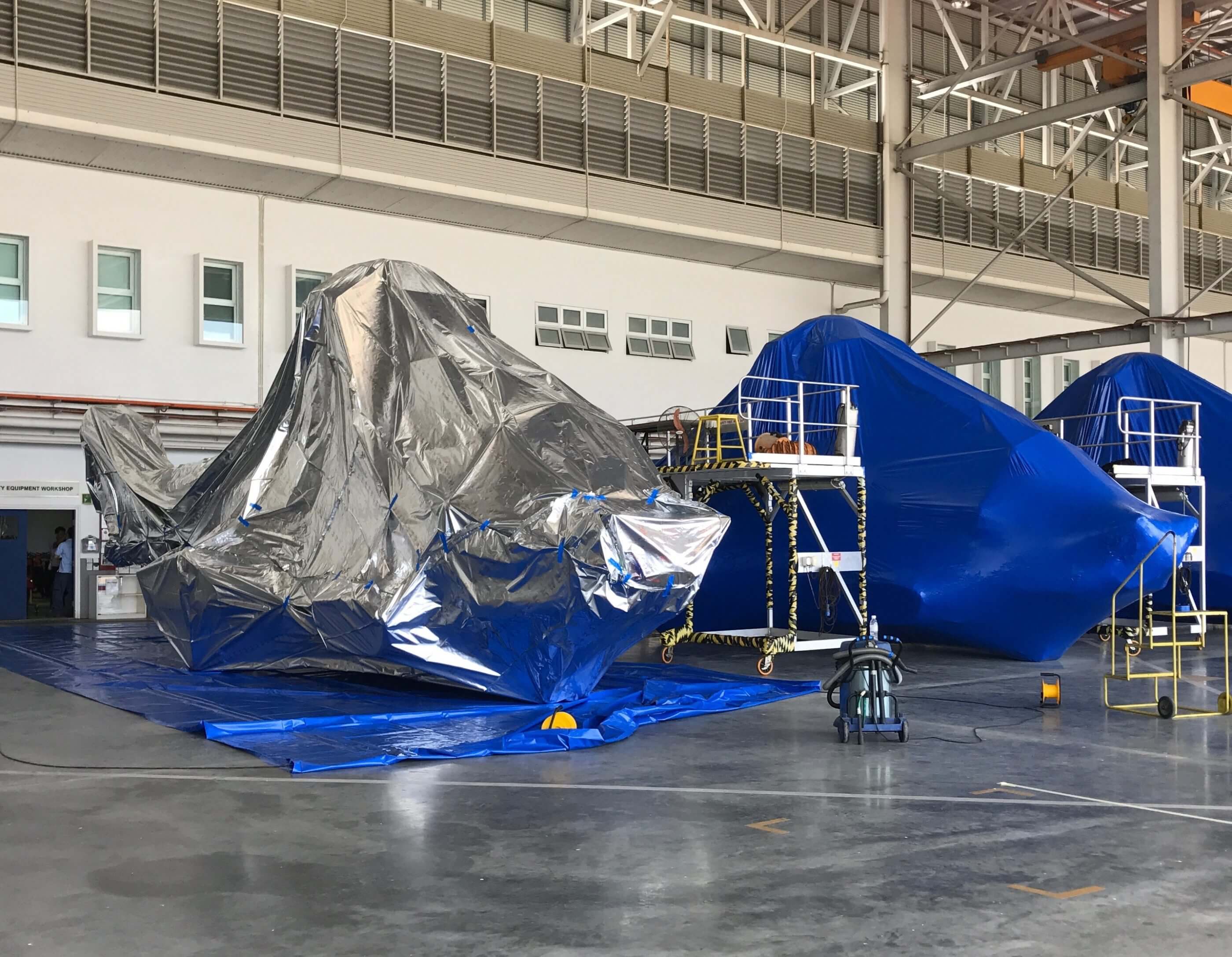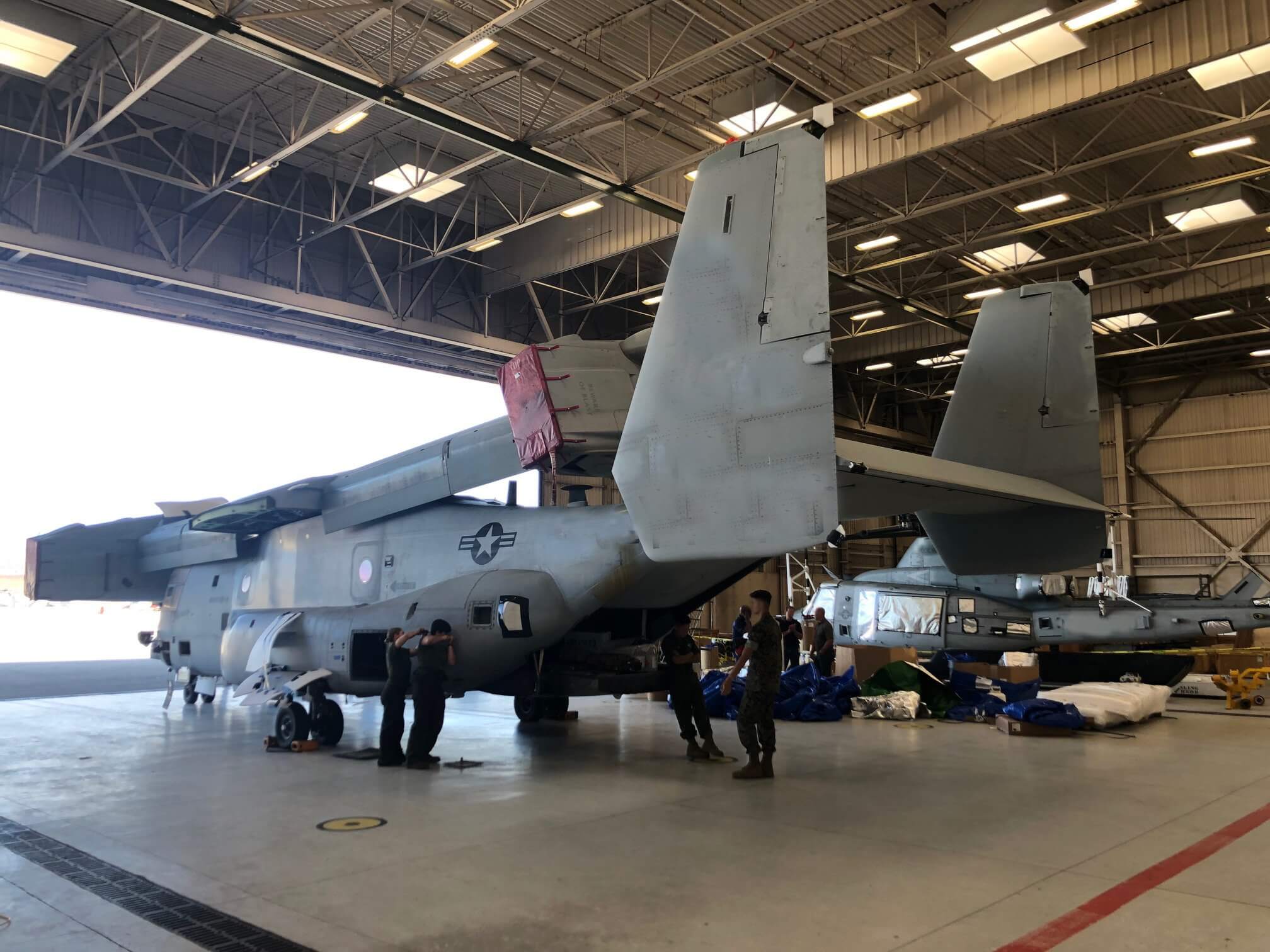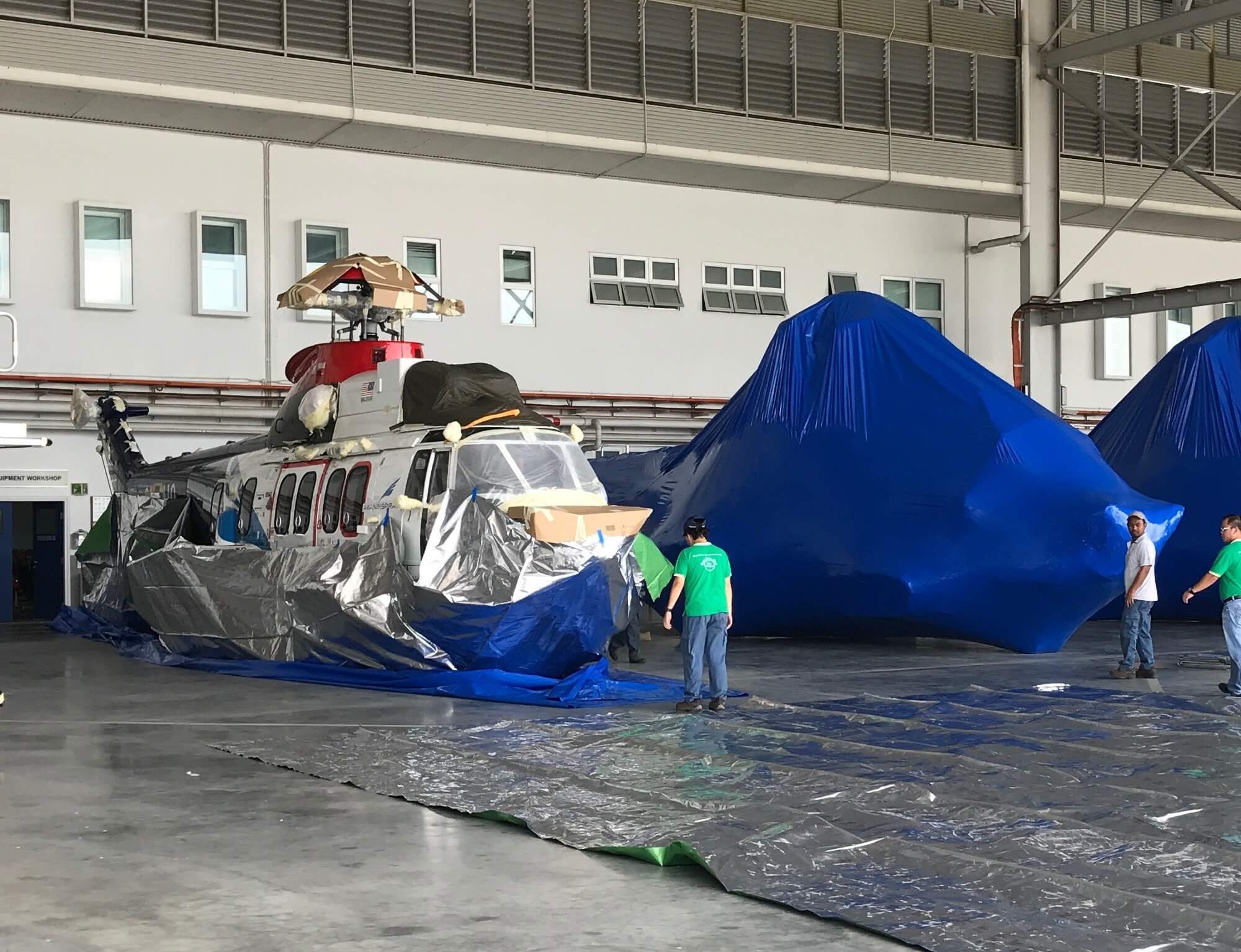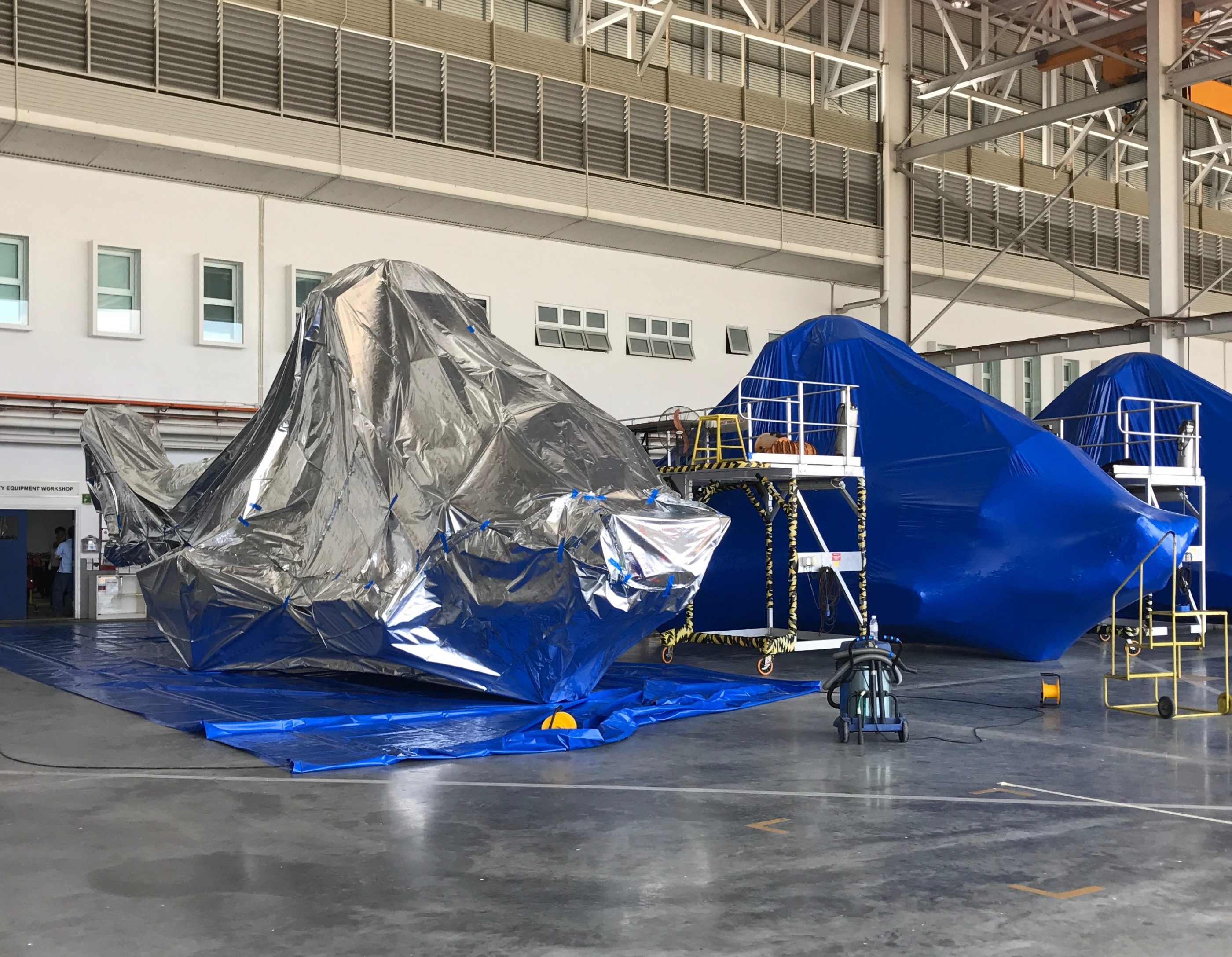As helicopter operators and airlines around the globe are grounding flights in response to Covid-19, the oil-and-gas market, and other pressures, they are scrambling for cost-effective ways to preserve out-of-service aircraft. In the absence of adequate hangar space, many companies have been forced to simply park aircraft on idle ramps or runways at airports and let Mother Nature take her toll.

However, long-term exposure to the elements can present problems for aircraft when not in use. Moisture can collect, causing rust and corrosion in gas tanks, fuel lines, and engines. Sunlight can deteriorate tires and damage paint. Pests can make nests in small access points or do damage by chewing through wires and components.
To keep grounded aircraft in good condition, companies have only a few options. One is a labor-intensive maintenance schedule, in which technicians and pilots regularly inspect and run up aircraft to keep them in working order. Another is to park them in a climate-controlled warehouse; however, warehouse space is costly and limited.
Protective Packaging Corporation offers an alternative: AirProPak preservation kits that completely enclose helicopters and planes in layers of vacuum-sealed, mil-spec moisture barrier packaging, allowing them to be stored indoors or out. Protective Packaging developed this preservation process through years of working with the U.S. military and private companies to store a variety of equipment and machinery. Within the last five years, the company has customized the process to meet the needs of helicopter companies all over the world to preserve helicopters during transport and storage.

This preservation method is a modern twist on mothballing or cocooning. The process includes unique, flexible, yet robust, moisture barrier films designed to keep even minimal amounts of moisture and humidity from reaching the aircraft, its engine, and electrical parts, ensuring no corrosion for a minimum of three years.
Vacuum sealing removes all moisture and air and aids in completely controlling the environment around each helicopter, without the expense associated with indoor climate control. To ensure the low humidity inside each package, desiccant is distributed throughout the aircraft while humidity sensors on the outside provide a real-time indication of the relative humidity for the remainder of the packaging. A heavy-duty shrink film is then added as the outer sacrificial layer, protecting the inner heat sealed foil. (More about this process can be viewed here.)
A proven record
The Covid-19 pandemic isn’t the first-time helicopter companies have had a need for Protective Packaging’s services. In 2016, the oil industry downturn idled millions of dollars of oil-and-gas equipment worldwide, including nearly a fifth of the helicopters used to ferry workers and supplies to offshore rigs. In response, a major offshore helicopter operator turned to Protective Packaging to help it preserve its inactive fleet.

“Using our experience in helping protect idled U.S. military equipment, vehicles, planes, and technology from environmental factors and idleness, we were able to develop and install a complete solution for the helicopter operator,” said Steve Hanna, CEO of Protective Packaging Corporation. “Our solution is much more cost-efficient than an expensive controlled environment warehouse or hangar.”
The helicopter operator, serving offshore rigs in the North Sea, needed to protect its idled aircraft from corrosion, mold, mildew and other environmental factors until market conditions changed. They also needed access to rotate the blades periodically during storage. The company wanted to make sure the aircraft would not require any cleaning or refurbishing when they were finally needed for service.
Using its flexible moisture barrier films, Protective Packaging provided a packaging process that completely controlled the environment around the aircraft. Protective Packaging technicians traveled to Scotland in March and completed the entire application process in less than a day.
The oil industry downturn had far-reaching effects in the helicopter industry, forcing CHC Helicopter to declare bankruptcy in May 2016. As a result, banks owning some of its leased assets repatriated to France 21 Airbus H225 helicopters from destinations as far away as Uruguay and East Timor. Very quickly the question arose as to their storage before a possible resale. And that’s where Airtelis came into play.

The company was created in 2011 to market the know-how of RTE (Réseau de Transport d’Électricité, France’s electric transmission system operator) in the field of helicopter-borne work and aerial maintenance. RTE is EASA part M and part 145 certified and employs around 30 mechanics and airworthiness specialists across its various French bases. The 21 H225s arrived on trucks in Avignon between August 2016 and January 2017.
At first, the storage arrangements responded to short-term constraints. But after a year, with the aircraft not selling, the decision was made to place them under cocoon to cope with longer storage. “It is a process which costs a little more [than no cover at all] but which is very preferable in the long term,” explained Rémi Magar, technical director of Airtelis. “We called on the American company Protective Packaging Corporation, which came to Avignon to train our operators. We worked together on the first three devices, and then we were autonomous in the implementation of the process.”
This process has been qualified by Airbus Helicopters, and Airtelis plans to use its new know-how to treat other fleets of idled aircraft in the months to come.
Besides oil-and-gas industry-related customers, Protective Packaging has provided long-term packaging preservation for many of the top aircraft manufacturers and defense contractors in the world, as well as for the electronics, communications, and transportation industries. Additionally, this process is used by a division of the U.S. Marine Corps to preserve Osprey, Huey, and Cobra rotorcraft stored outside, and a similar but smaller-scale process is used to preserve helicopter engines while stored in cans.
Protective Packaging Corporation is a Texas-based, ISO-certified, veteran-owned small business corporation that has been in business over 35 years. For more information, visit www.protectivepackaging.net.
This article is sponsored by Protective Packaging Corporation.









